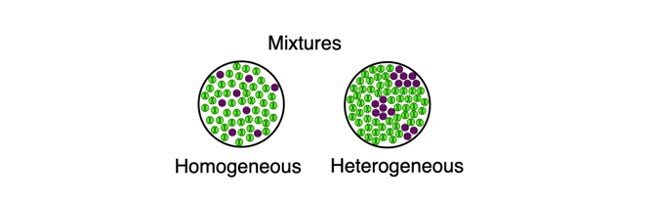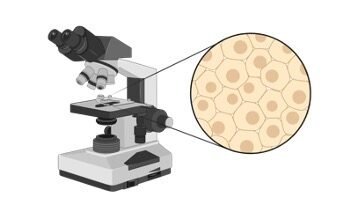Heterogeneous Mixtures Introduction
Anything which has mass and occupies space is called matter. Matter can be divided into;
1. Pure Substances
2. Mixture
Pure substances are made up of only one form of atoms or molecules which cannot be broken down into simpler substances by simple physical method. Element and Compound are examples of pure substances.
Mixtures are made up of two or more substances which are the constituents of mixture. The constituents of mixture can be in any ratio.
Mixtures can be divided into:
1. Homogeneous mixtures
2. Heterogeneous mixtures
Homogeneous mixtures have uniform composition. For instance, sugar in water, water in alcohol etc.
What are Heterogeneous Mixtures?
Heterogeneous mixtures are defined as the mixture where components are mixed non-uniformly. Irrespective of homogeneous mixture where components are in single phase, in heterogeneous mixture components are present in at least two different phases.
Properties of Heterogeneous Mixtures
Heterogeneous mixture shows the following properties:
• It contains two or more ingredients or phases. This phase can be solids, liquids, or gases.
• All the constituents hold their individual properties or chemical identity.
• Constituents displays variable composition.
• The components of mixture can be separated by physical methods.
• There is usually no energy change when mixture is formed.
• There is no change in volume in forming mixture at constant temperature and pressure.
• We cannot transcribe the formula for heterogeneous mixture.
Classification of Heterogeneous Mixture
We can broadly classify heterogeneous mixture into two types:
1. Suspensions
2. Colloids
1. Suspensions
In this type of mixture solute particles do not dissolve, but remain suspended throughout the medium.
Properties of Suspension
1. The particles of a suspension are big and can be seen with a naked eye.
2. As the particles size is pretty big, they throw a beam of light and make the track of light visible, this effect is called The Tyndall effect.
3. As solute particles are quite big, they also settle down when the mixture is left uninterrupted so it can be said that suspension is unstable.
4. The elements of the suspension can be separated by a method of filtration.
Examples of Suspension
1. Kerosene oil and water are the two liquids that do not combine with each other; thus, these types of liquid are called immiscible liquids.
2. Muddy water is also an example of suspension where sand particles are suspended in the liquid water.
3. Common salt in benzene.
4. Wheat flour in water.
5. Concrete is a combination of cement, gravel, sand, and water thus it is an example of suspension.
6. A tossed salad
7. Ice cubes in soda. Before opening it appears to be homogeneous but once heaviness is released, we see the bubbles of gas and liquid.
8. Smoke, an example of suspension in which dust particles, gases, carbon particles are present in different ratios.
Colloids
Colloids are another type of mixtures where the size of particles is between 1nm and 1000nm. Colloids is defined as a mixture where one of the substances is divided into very minute particles which are distributed throughout a second substance. These tiny particles are recognized as colloidal particles.
Properties of Colloids
1. Collides are heterogeneous mixture.
2. When light is conceded through a true solution, the dissolved atoms are too small to deflect the light. But, the dispersed particles of a colloid, being bigger, do deflect light. Thus, The Tyndall effect is the scattering of visible light by colloidal particles.
3. Particles of colloids do not settle at bottom when we left the mixture uninterrupted.
4. Colloids cannot be filtered.
5. The two components of colloidal solution are given below;
i. The dispersed phase: The dispersed particles in a colloid form.
ii.The dispersing mediums: The component in which particles are suspended which are solid, liquid or gas.
Types of Colloids
The dispersion mediums are of three form gas, solid and liquid state. Similarly dispersed phase can be of three types. Based on these two we divide colloid in eight types:
1. Solid sol
2. Solid foam
3. Solid aerosol
4. Sol
5. Gel
6. Emulsion
7. Aerosol
8. Foam
| Colloids | Dispersing Medium | Dispersed Phase | Types |
| Clouds, fog, mist, smoke, automobile exhaust | Gas | Liquid Solid | Aerosol Aerosol |
| Shaving cream, face cream, blood, paint, writing ink, mud, milk of magnesia | Liquid | Gas Liquid Solid | Foam Emulsion Sol |
| Rubber, foam, sponge, pumice, jelly, butter, cheese, colored gemstone | Solid | Gas Liquid Solid | Foam Gel Sol |
Based on nature of the different interactions between the dispersion phase and dispersed phase:
1. Lyophilic If there is an affinity between dispersed medium and phase then these sols are called lyophilic.
For Example: starch, rubber, protein, etc.
2. Lyophobic If there is no affinity between the two phases then these form an unstable colloid.
Examples: sols of metals like gold and silver, sols of metallic hydroxides.
Methods of Separation of Components of Suspensions and Colloids
1. Filtration that is done with the help of filter paper
2. Separating funnel for immiscible liquids such as in oil and water
3. Sedimentation and decantation
4. Centrifugation where mixtures are rotated at a very high speed so that the lighter particles are detached from mixture for example: cream from milk.
Test Used to Identify; Suspensions and Colloids
1. A colloid solution is translucent or turbid in nature and if salt is added to this solution, then this can settle at bottom.
2. If the particles settled at bottom is left uninterrupted for some time then it is a suspension.
Use of a Colloid and a Suspension in Our Daily Life
Colloids are used in pharmaceuticals some insoluble materials become more active when taken in colloidal form.
Suspensions: Barium sulphate when dispersed in water form an opaque suspension which is used in diagnostic X-rays.
Heterogeneous Mixtures Citations
- A density-based threshold model for evaluating the separation of particles in heterogeneous mixtures with curvilinear microfluidic channels. Scientific Reports volume 10, Article number: 18984 (2020).
- The electrical properties of heterogeneous mixtures containing an oriented spheroidal dispersed phase. Colloid and Polymer Science volume 263, pages51–57 (1985).
Share




















